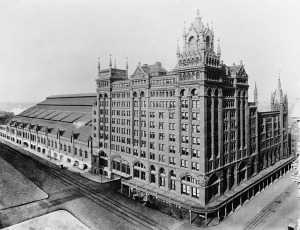Related Topics
Railroad Town
 It's generally agreed, railroads failed to adjust their fixed capacity to changing demands. It's less certain Philadelphia was pulled down by that collapsing rail system.
It's generally agreed, railroads failed to adjust their fixed capacity to changing demands. It's less certain Philadelphia was pulled down by that collapsing rail system.
Creating and Wrecking the Penn Central

|
| Penn Central |
In 1957 President James M. Symes of the Pennsylvania Railroad proposed a merger with the New York Central Railroad. If politics and unions prevented modern railroads from increasing productivity by eliminating internal waste, perhaps a merger would create the potential for pruning the consequent duplications of service. Unfortunately, the merger couldn't take place without governmental permissions, so the same combination of unions and government blocked a merger as blocked revisions of union work rules and political insistence on unprofitable services. That blockade worked and it didn't work. Internal deal-making in the government finally maneuvered it into happening, but only after eleven years. It was probably the eleven years of worsening delay which made the merger collapse after two years of existence. The Penn Central really needed twenty years of good luck to be certain of success, but with twelve years it might at least have had a chance.
It was hard enough to get the two boards of directors to agree on a merger; the New York Central was in such bad shape Pennsylvania would surely be the dominant internal survivor. The real battle, however, was the political one of securing government permission to merge. It was quickly apparent that Democrats were opposed, Republicans in favor. Democratic Governor Lawrence and Democratic Mayor James J. Tate of Philadelphia were both opposed, and it was easy to see the union influence on their minds. When Democratic President John Kennedy revealed his opposition, it was clear where the party stood, and negotiations were almost dropped after two years. The assassination of President Kennedy brought Lyndon B. Johnson into the matter, and the Pennsylvania RR soon appointed a close friend of his, Stuart Thomas Saunders as their CEO. Saunders was a real railroader, having worked for twelve years for the Norfolk and Southern, but he was mainly a politician in several ways. On arriving in Philadelphia, he was immediately welcomed into prestigious Philadelphia social circles and made rather a splash. In time, President LBJ appointed former Governor Lawrence to some advisory boards and he switched his position on the Penn Central merger. Soon, Mayor Tate relaxed his opposition, and it was all done. The Republicans were always in favor, Governor Scranton reversed the gubernatorial position, and now the Democrats were top to bottom in favor. Unfortunately, Milton J. Shapp was not in favor. Mr. Shapp had sold his Community Antenna Television system for $10 million and seemed anxious to get involved in politics. Apparently sensing an issue which might put him in charge of Pennsylvania Democratic politics, he launched a loud and bitter crusade against the merger. It is not publicly known whether the Johnson administration attempted to dissuade him, but it would be surprising if they hadn't. At this point, Walter Annenberg the owner of the Philadelphia Inquirer and the largest stockholder of the PRR launched a pro-merger and anti-Shapp campaign which grew increasingly bitter as Sharp stood for election as Governor and was elected in 1970. Under the circumstances, the PRR was bound to be pleased with Annenberg, and Saunders launched a campaign to make him socially acceptable in the circles where he was now a great lion. Annenberg's father had gone to prison, and the largest profit center in the news empire was the horse-racing form, although TV Guide eventually surpassed it, so his social rehabilitation was surely welcome. Eventually, he was appointed Ambassador to England. After eleven years of hard work and devious tactics, the Penn Central merger came into effect in 1968. It lasted only two-plus years.
Even without an additional ten years of increased indebtedness and protracted deferred maintenance, the merger would have been hard to do. It was the largest corporate merger in American history. It was the largest owner of commercial real estate in America, with not only Penn Center in Philadelphia but nineteen high-rise office buildings around Grand Central Station in New York. Myriads of conflicting policies and equipment, from data processing programs to locomotive signaling, had to be reconciled. Savings were expected from eliminating redundancies, but redundancies went to court, and employees near retirement demanded their rights. The unions had lost a battle and sulked. Former New York Central employees sulked. A million things went wrong and no one had the experience to fix them. The final collapse was financial, and in a curious way similar to the later collapse of Lehman Brothers. The Penn Central had a huge payroll and needed huge amounts of cash to pay them. The new way of handling this was to maintain cash as short-term commercial credit notes, buying new ones every few days as the old ones expired. But now there was a new way to have a "run on the bank". When the commercial credit markets were bothered by the news or only a rumor, they stopped replacing the notes. As rumors spread, the Penn Central suddenly found it did not have the money to meet its payroll. It was all over, except for the bankruptcy hearings.
Originally published: Thursday, November 04, 2010; most-recently modified: Monday, May 20, 2019